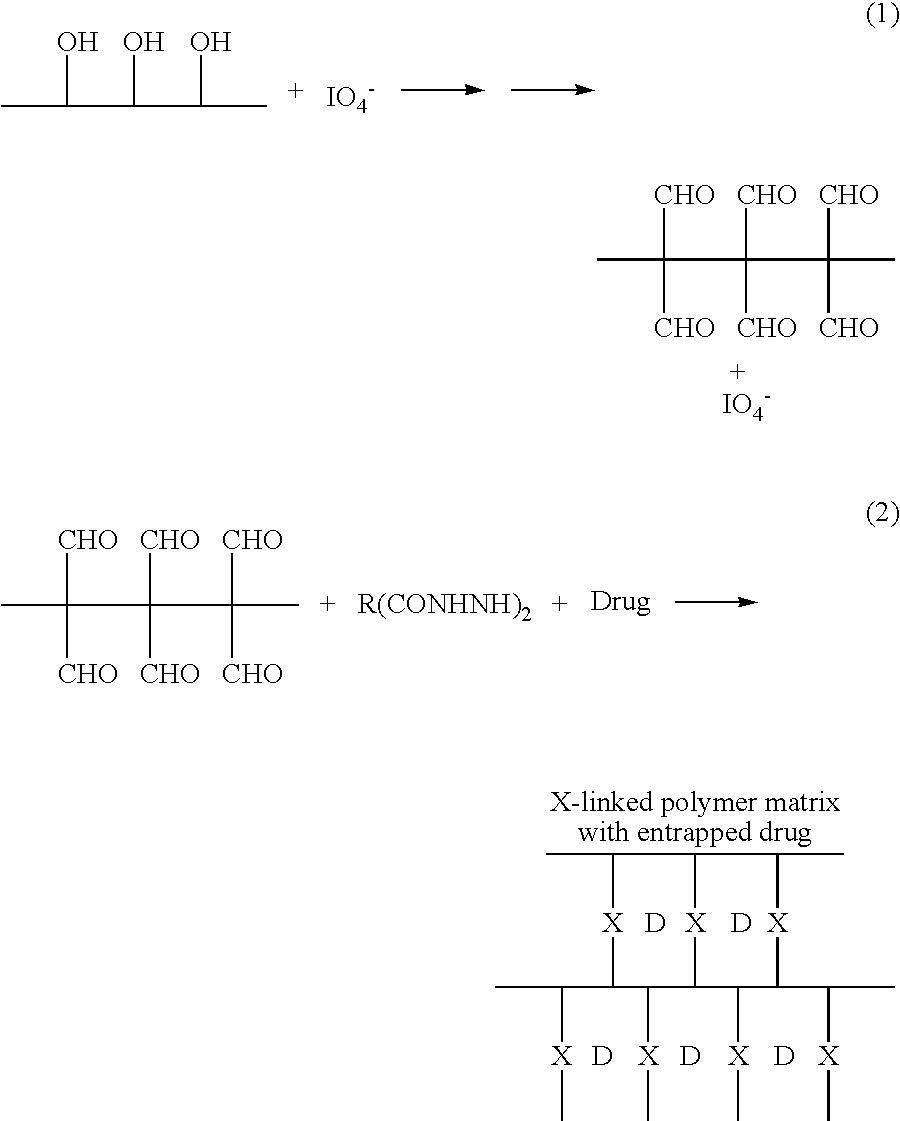Bioresorbable polymer matrices and methods of making and using the same
a bioresorbable polymer and polymer matrices technology, applied in the field of bioresorbable polymer matrices, can solve the problems of less convenient and more expensive disclosed methods compared to the system, inability to commercially obtain starting materials, and inability to prevent amino group reaction, etc., to achieve the effect of maintaining sterility, preventing the reaction of amino groups, and ensuring the stability of bioactive agents
- Summary
- Abstract
- Description
- Claims
- Application Information
AI Technical Summary
Benefits of technology
Problems solved by technology
Method used
Image
Examples
example 1
Preparation of Oxidized Dextran
[0058] Dextran (4 g; Mw 500,000) was dissolved in 20 ml distilled water. To this solution was added 535 mg of finely ground NalO4 with rapid stirring. The mixture was stirred in the dark for 1 hour and then dialyzed against three changes of distilled water (1 L each). The oxidized dextran solution (about 70 mg / ml) was stored at room temperature in the dark. The solution was concentrated with a rotary evaporator at 40° C. to about 200 mg / ml.
example 2
Ciprofloxacin / Clindamycin Matrix
[0059] Oxidized dextran solution, prepared as described in Example 1 (1 ml, 93 mg / ml), was loaded into a 3-ml syringe. A finely ground powder containing 21 mg adipic dihydrazide, 20 mg citric acid, and 150 mg ciprofloxacin was loaded into a second 3-ml syringe. The syringe, which contained about 0.5 ml of air along with the powder mixture was closed with a plug-type cap.
[0060] Just prior to use the two syringes were coupled using a double-ended connector. The contents of the syringes were mixed during about 30 reciprocations. Installation of the mixture into a wound may be accomplished via a needle or cannula attached to the syringe containing the mixture. The setting time for this formulation is 8-10 minutes.
[0061] Substitution of a mixture of ciprofloxacin and clindamycin (75 mg each) for ciprofloxacin yields a broad spectrum formulation covering anaerobes as well as aerobes.
example 3
Preparation of Bupivacaine FB / CMC Matrix
[0062] Bupivacaine (100 mg) was placed into a mortar and ground with 100 mg carboxymethylcellulose sodium (CMC) (Mw 70,000). Oxidized dextran (Mw, 500,000; 66 mg / ml; 1 ml) was blended with the bupivacaine / CMC mixture at room temperature. After a homogenous suspension was obtained, adipic acid dihydrazide (7.8 mg) was added. A sample (200 mg) of the resulting gel was transferred to a 2 ml centrifuge tube for the release experiment in PBS buffer. The release profile of the formulation appears in Table 1 below:
TABLE 1Day% Release / Day1102103104955657583
PUM
| Property | Measurement | Unit |
|---|---|---|
| concentration | aaaaa | aaaaa |
| melting point | aaaaa | aaaaa |
| melting point | aaaaa | aaaaa |
Abstract
Description
Claims
Application Information
 Login to View More
Login to View More - R&D
- Intellectual Property
- Life Sciences
- Materials
- Tech Scout
- Unparalleled Data Quality
- Higher Quality Content
- 60% Fewer Hallucinations
Browse by: Latest US Patents, China's latest patents, Technical Efficacy Thesaurus, Application Domain, Technology Topic, Popular Technical Reports.
© 2025 PatSnap. All rights reserved.Legal|Privacy policy|Modern Slavery Act Transparency Statement|Sitemap|About US| Contact US: help@patsnap.com

